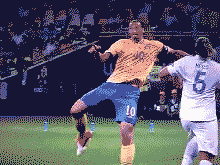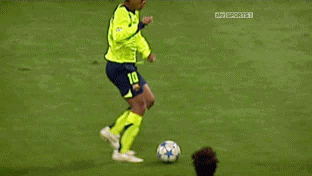Get In Soccer Shape - The SMART Way!
In the sport of soccer (or as the rest of the world says it, Football), a lot of issues we see arise with different soccer players who contact Garage Strength either directly within the gym or DM and message us tend to talk to us about concerns of getting slower. The athletes express the feeling that they are getting slower and weaker. They say that they are running all the time for long durations.

What we see happening is that soccer has a prevalent culture of doing a lot of endurance work. From all this volume, soccer athletes mayhave knee issues, ankle pain, shin splints, or lower back problems that lead to issues with cutting just from the handling of conditioning and an over amount of volume.
Soccer players will be told they don’t have to go into the weight room, no need for strength-based work, and just get out on the field and run a few laps and athletes will be fine. But the issues don’t go by the wayside. They just continue and progress from season to season. Athletes feel the wear and tear as the seasons add up and age stacks up.
It doesn’t have to be this way.
Instead, we can condition soccer players to be more explosive, better equipped, and have improved conditioning later in the competition.
5. Coordinated Endurance & Acceleration
Reading the words coordinated endurance and acceleration might make one think they’re on the opposite end of the spectrum. We might think of endurance as the ability to run for four to six minutes at a time without getting gassed. Soccer is a sport that the game lasts for ninety minutes. Athletes have to have good endurance to play the sport effectively. On top of that, there is a lot of stopping and going in soccer. There is a lot of cutting in soccer. There is a lot of moments in the game where the jets need to be turned on to accelerate.
Combining the coordination of dribbling the soccer ball with endurance and acceleration, we can arrive at the obvious (once it is said) that we have to be coordinated over really long periods of time. We have to have good foot-eye coordination. We have to be able to handle different cutting positions late in the match when fatigued. This means we have to have solid footwork over long-duration.

We recommend that when going out for long-duration jogs, go out on the soccer field once a week with an actual soccer ball. This will improve coordinated endurance late in the game greatly. On top of that, if we are going to do acceleration work, we need to do the acceleration-based work for speed and cutting both with and without a soccer ball. The two sides can actually be done together. Do it without the ball and then do it with the ball. This needs to be done about twice a week.
Athletes with high-speed coordination that involves acceleration find themselves able to dribble the soccer ball in a superior manner to get in and out of cuts to dominate opponents on the pitch. Build this skill by training through coordinated endurance and acceleration protocols.
4. Alternative Plane Endurance
When we talk about alternative plane endurance we want to think about what happens with defenders and offenders when they are on the move without the ball. They may be moving backward, sideways, crossing their feet over, and, at a point, they might be going sideways and backward simultaneously. This means soccer athletes need to be able to open their hips to get into the best positions. This also means soccer players need to have really good endurance in these different planes.

Soccer players need to train to do side shuffles, carioca, side skips, driving with the opposite leg, and the backpedal position. We recommend at least once a week setting up a period of fifteen-plus minutes to focus on all the drills and movements that train the endurance for alternative plane movements.
Utilize this different work throughout the endurance and improve athletes’ overall coordination while improving their conditioning. Now we don’t want to beat athletes up and run them into the ground so it can be used as a warm-up or finisher. It can even be done while incorporating passing drills if needed.
3. DTC Conditioning
DTC, or dynamic trunk control, is a holy grail of power generation and being athletic. DTC is the trunk: the abs, obliques, and back. DTC is the utilization of all these muscles so that when we cut we are not allowing our upper body to collapse.

With a fatigued DTC, we don’t have as much control from being fatigued. We need the conditioning and endurance with DTC to be able to cut rapidly, make strong reads on the field, and keep performance impactful. Something we can do training to trigger improvement of DTC later in the game is holding a plank for a minute and then go and do an agility drill with the soccer ball. This is an old-school bodybuilding concept: pre-fatigue the trunk and then have to go and coordinate at a greater rate when performing the agility drill. The exercises used in this manner are only limited by imagination. Just remember to keep it applicable and as specific to soccer as possible. Another idea can be done by doing an explosive dumbbell snatch into a sprint holding a 10k plate overhead while doing high knees, training DTC with actual sprint mechanics.
Utilize these concepts twice a week as a warm-up or at the end of practice to improve DTC conditioning to help maintain the high rate of coordination for superior cuts late in the game.
2. Weight Room Work
It has been our experience that some soccer coaches don’t want their athletes in the weight room. They’re worried about the athletes coming out looking like bodybuilders.
There are manners we can train in the weight room to improve soccer abilities. It will lead to greater strength to improve striking ability. But this is about conditioning. So let’s talk about conditioning within the weight room.

For instance, we can do OTM (on the minute) full cleans for fifteen minutes. Maybe we do two reps every minute. This will improve DTC, our ability to accelerate and improve core stability for greater alternative plane endurance.
We can also do long-duration isometrics to improve unilateral positions. We can do bigger sets to improve our strength endurance. For instance, we can do single-leg squats for a set of twelve on each leg and then hold at a ninety-degree for thirty to sixty seconds in an isometric position. Now we are improving unilateral strength and endurance in the weight room using isometric and big sets.
Get creative with weight room work to drastically improve overall performance!
1. In-Game Work
This one transfers the best to the actual sport.
Based on position, we want to understand how many meters each positional group has to stop, go, and run. We want to either time how long each position is running or measure the distance. Tally the average interval the positions run for, accelerate for, and cool down to figure out how often they have to get going, recover, and make moves. It may be fifty-plus starts of ten-second sprints. It may be more. It may be less. But each position will be different.
By breaking this down, we can use this information to train each position. We can do interval-based work derived from the timing frequencies brought about from studying the data. This allows us to do in-game work derived from the timing frequencies. We can give longer rest periods to focus on speed. We can do shorter rests over a longer period of time to improve endurance. Be creative with it.
Recap
Conditioning for soccer needs to be done intelligently. Just going out for a run will only get athletes so far. Athletes need to be training in a manner that develops their conditioning in all aspects of the game. Conditioning that takes into account acceleration late in the game, technical abilities as fatigue sets in, power output as fatigue sets in, superior DTC, and utilizing interval-based training that is derived directly from an in-game study based upon position. At the very least, take these concepts and apply them to conditioning training in a creative and intelligent manner and then marvel at the results.
Let us know how it goes by commenting below.
DANE MILLER
Dane Miller is the owner and founder of Garage Strength Sports Performance. He works with a select handful of clients on building comprehensive programs for fitness and nutrition. Several times a year he leads a workshop for coaches, trainers, and fitness enthusiasts.


